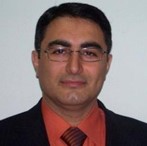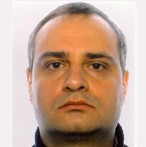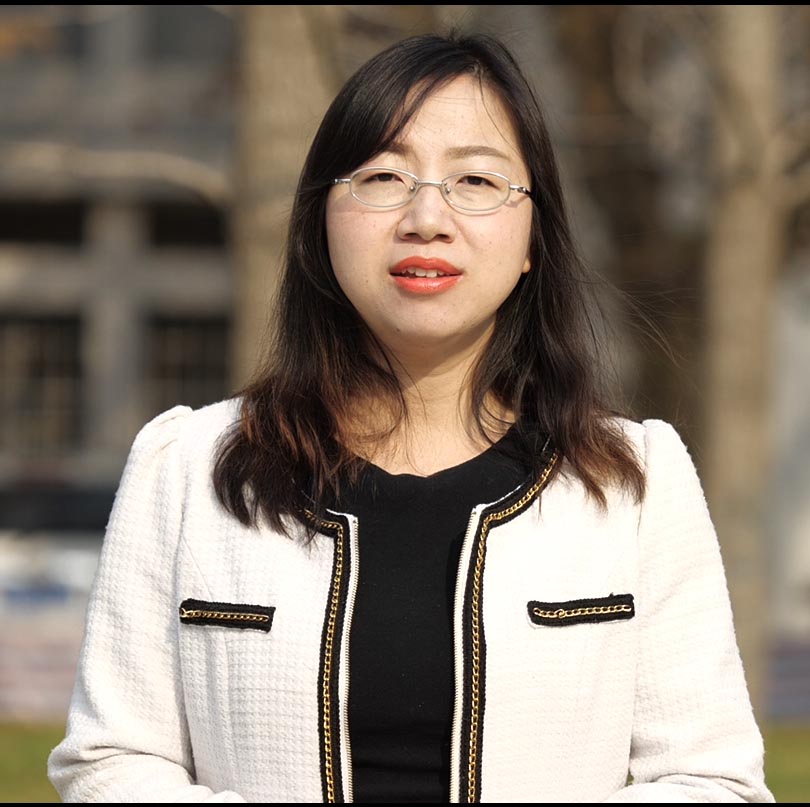Invited Speakers
Dr. Dmitry Zaitsev, Professor
Department of Information Technology, Odessa State Environmental University, UkraineSpeech Title: Synthesis of fuzzy logic functions defined in tabular form
Abstract: The early published method of a continuous (fuzzy) logic function synthesis on a choice table has been adjusted for fast partitioning the source choice table with a set of fuzzy logic functions. Constituents of minimum and maximum have been introduced, their properties studied. A toolbox for fuzzy logic functions synthesis on a choice table, available for free download on GitHub, has been implemented in C language. The toolbox implements a command line style of programming using data located in textual files of simple intuitive formats. The toolbox can process big data rapidly and can be easily integrated into fuzzy logic frameworks as a synthesis engine for developing graphical environment of fuzzy (control) systems design. It has been proven that obtained decomposition into a set of fuzzy logic function contains the minimal number of fuzzy logic functions.
Dr. Giuseppe Di Fazio, Professor
University of Catania, ItalySpeech Title: Gradient Estimates for Weak Solutions of Elliptic PDE's
Abstract: Let us consider an elliptic equation of second order in variational form in a bounded domain of the Euclidean n dimensional space. The right hand side is a function satisfying suitable assumptions. The problem of gradient estimates for elliptic equations is very important both from theoretical and applied point of view. In this talk we exploit what is the heart of the technique to show gradient estimates allowing the function f to belong to very general function spaces. Our technique is very flexible and it is allowed to show existence, uniqueness and well posedness of the Dirichlet problem in several classes.
Dr. Ali Farajzadeh, Professor
Department of Mathematics, Faculty of Science, Razi University, Kermanshah, IranSpeech Title: On fuzzy Differential Equations in Normed Spaces
Abstract: In this talk, we present fuzzy differential equations (FDE) in the setting of normed spaces by introducing new definitions and extending the H-differentiability to normed spaces. This concept stands on the expansion of the class of differentiable fuzzy mappings and, for this, the lateral Hukuhara derivatives should be propounded. We will see that both derivatives are different and they lead us to different solutions from a FDE. Some illustrative examples are also given and some comparisons with other methods for solving FDE are made.
Dr. Igor Temkin, Professor
Department of Automated Control Systems, National University of Science and Technology, RussiaSpeech Title: Intelligent Control of the Autonomous Dump Trucks Movement in the Quarry based on Digital Twins and Soft Computing Models
Abstract: This article discusses modern modeling technologies that open up new opportunities in solving the problem of autonomous robotized heavy dump trucks control in the open pit mine. Specific approaches to the intelligent management of transport and technological operations are mentioned while the extraction of mineral raw materials is discussed. A brief overview of methods and tools for modeling technological processes in open pit mining is given. It is proposed to use the instrumental environments of the gaming industry platforms and virtual reality systems as a toolkit for solving problems related to modeling the dynamics of autonomous mobile objects in 3D. The classes of agents introduced by us for the convenience of structuring the tasks to be solved are briefly described. The main developed functional elements and algorithms, which using fuzzy models of the intelligent control are given, as well as the generalized structure of the control system for technological processes in the quarry. The principles of operation are described, and the advantages of a particular tool for creating digital 3D models are discussed. Some results obtained in the course of the modeling of the transport cycle with the use of digital 3D model of the quarry and digital shadows of mobile objects are presented.
Keywords: intelligent control, autonomous robotized heavy dump truck, digital modeling, digital twin, soft computing, algorithms of prediction, optimization and fuzzy control
Dr. Stefania Tomasiello
the Institute of Computer Science, University of Tartu, EstoniaSpeech Title: On Least-Squares Fuzzy Transforms and Autoencoders
Abstract: In this talk analogies and differences between a type of fuzzy transform and a type of autoencoder, both based on a least-squares optimization, will be presented. Such schemes have been recently introduced in the literature in different contexts. As it will be shown, the least-squares fuzzy transform can be regarded as a kind of autoencoder with a lower computational cost.
Dr. Gianni Betti, Professor
Department of Economics and Statistics, University of Siena, ItalySpeech Title: Price promotion strategies in CPGs: A multidimensional Fuzzy framework to evaluate business results
Abstract: This research aims to provide a fuzzy and multidimensional framework for evaluating the economic outcome of price promotion strategies in the CPG market. Price promotions in the form of temporary price reductions are a relevant driver for sales in CPGs. However, the literature debates their efficacy in building long term market share. We provide a framework for testing the results of different price promotion strategies, classified according to a multidimensional fuzzy index. We tested our model on a database of reported weekly prices and promotions for pasta Brands across different retailers and NUTS1 Areas in Italy. The database has been elaborated to impute missing data and correct for reporting inconsistencies. Pricing and price promotions strategies are classified for every year across the different retailers and NUTS1 areas according to three dimensions: regular price level, temporary price reduction frequency, and temporary price reduction depth. For each dimension we designed membership functions to accommodate the membership in up to 2 adjacent categories. Different membership function approaches have been compared, using linear and non-linear methodologies to fuzzify the transition of items between membership in adjacent categories. The resulting multidimensional indexes have been used to classify the Brand strategy, using the retailers market share as a weight for aggregation on each brand. Market shares for pasta Brands have been derived empirically according to limited data available. We finally associated each Brand strategy to the change in its market share, searching for relations between strategies and their outcomes.
Keywords: Fuzzy Logic, Consumer Packaged Goods, Pricing, Price Promotion Strategies, Market share
Dr. Lanyong Zhang, Associate Professor
College of Automation, Harbin Engineering University (HEU), ChinaSpeech Title: Research on Multi-UAV Cooperative Control Based on Consistency Theory and Fuzzy Control
Abstract: Multi-UAV (Unmanned Aerial Vehicle) systems have been the focus of research in the military field at home and abroad in recent years. UAV combat systems have also evolved from “single-platform remote control operations” to “multi-UAV autonomous cluster operations”, supporting combat systems with the characteristics of coordination, autonomy, flexibility under uncertain tasks and environments. The report briefly introduces the development of UAVs, UAV system models, UAV autonomy levels, and UAV cooperation issues. The cooperative control principle based on consistency theory and fuzzy control is given, the cooperative control of formation and obstacle avoidance is introduced, and the cooperative control algorithm based on virtual force is constructed. A brief description of the next research plan is given.
Keyword: Multi-UAV; Cooperative control; Consistency; Fuzzy control; Formation and obstacle avoidance
Dr. Norihiro Kamide, Associate Professor
Department of Information and Electronic Engineering, Teikyo University, JapanSpeech Title: Inconsistency-tolerant Fuzzy Description Logics
Abstract: Description logics are well-known to be a family of logic-based knowledge representation formalisms, and fuzzy description logics are expressive description logics for representing and handling fuzzy (vague or imprecise) knowledge bases. Even though handling fuzzy concepts is known to be a significant issue in knowledge representation (KR) in AI, inconsistency handling is of growing importance in KR because inconsistencies can frequently occur in the real world. Thus, combining these issues is also regarded as a significant issue in KR, especially for realizing smart knowledge-based systems. Knowledge-based systems would be smarter, more robust, and more fine-grained if they were capable of handling inconsistent fuzzy knowledge bases. In this study, to effectively handle inconsistent fuzzy knowledge bases, an inconsistency-tolerant fuzzy description logic is introduced, and a translation from this logic to a standard fuzzy description logic is defined. A theorem for embedding the proposed inconsistency-tolerant fuzzy description logic into the standard fuzzy description logic is proved using this translation. A theorem for relative decidability of the inconsistency-tolerant fuzzy description logic with respect to the standard fuzzy description logic is also proved using this embedding theorem. The proposed logic and translation are intended to effectively handle inconsistent fuzzy knowledge bases. By using the translation, the previously developed methods and algorithms for the standard fuzzy description logic can be reused for appropriately handling inconsistent fuzzy knowledge bases that are described by the proposed logic. Furthermore, in this study, an inconsistency-tolerant fuzzy temporal next-time description logic is obtained from the inconsistency-tolerant fuzzy description logic by adding a temporal next-time operator. Similar results as those for the inconsistency-tolerant fuzzy description logic are also obtained for this temporal extension.
Dr. Mitsukuni Matayoshi, Professor
Department of Industry and Information Science, Okinawa International University, JapanSpeech Title: Tree Chromosome Structure in a Genetic Algorithm to Identify Functions
Abstract: The scientist finds laws from observed data. To find a law of nature automatically has long been human's dream. One famous attempt is Genetic Programming (GP), which is an expansion of the genetic algorithm (GA) to treat structural representations of functions directly as gene code with LISP. However one big problem in GP needs the huge amount of calculation time. In this presentation, tree Chromosome Structure in a genetic algorithm to Identify Functions which succeeds in function identifications called symbolic regression is presented. There are four main points in this presentation. First, the tree structure is mounted on a chromosome structure for simple GA. Second, the proposed method succeeded in identifying the target functions which are composed of algebraic functions, primary transcendental functions, time series functions include a chaos function, and user-defined one-variable functions from the observed data. Third, some local search methods which aims at the identification success rate improvement, shortening identification time and to find more sophisticated function representations. The introduced local search methods succeed in function identifications more than previously study. Indeed, some results show that when some functions were identified, the improvement of identification rate and shortening time were indicated. However, there are some ineffectual results. It would show that the solution, which means the each target function representation, is in unique search space. To propose new local search method is the most important research area now. And finally, the proposed chromosome structure can be adapted for identifying Boolean functions. The target Boolean functions have single output and single/multiple variable input.
Dr. Cheng Siong Chin
Reader (Associate Professor), Newcastle University, Singapore; Adjunct Full Professor, School of Automotive Engineering, Chongqing University, ChinaSpeech Title: Intelligent Acoustic Systems: Classifying Environments from the Sounds
Abstract: The neural networks using a combination of multiple Gated Recurrent Units (GRUs) layers in the Neural Network enhance ASC's accuracy. Due to the advantage of time sequence modelling, the GRUs can perform better class-based discrimination and mapping features. The results on the TUT Acoustic Scenes evaluation dataset demonstrates that the proposed model performs better in ASC than Long short-term memory layer. The average class-wise accuracy has shown improvement with the proposed method.
Dr. Khaled Almustafa, Associate Professor
Prince Sultan University, Saudi ArabiaSpeech Title: Prediction of Heart Disease and Classifiers’ Sensitivity Analysis
Abstract: Background: Heart disease (HD) is one of the most common diseases nowadays, and an early diagnosis of such a disease is a crucial task for many health care providers to prevent their patients for such a disease and to save lives. In this paper, a comparative analysis of different classifiers was performed for the classification of the Heart Disease dataset in order to correctly classify and or predict HD cases with minimal attributes. The set contains 76 attributes including the class attribute, for 1025 patients collected from Cleveland, Hungary, Switzerland, and Long Beach, but in this paper, only a subset of 14 attributes are used, and each attribute has a given set value. The algorithms used K- Nearest Neighbor (K-NN), Naive Bayes, Decision tree J48, JRip, SVM, Adaboost, Stochastic Gradient Decent (SGD) and Decision Table (DT) classifiers to show the performance of the selected classifications algorithms to best classify, and or predict, the HD cases. Results: It was shown that using different classification algorithms for the classification of the HD dataset gives very promising results in term of the classification accuracy for the K-NN (K=1), Decision tree J48 and JRip classifiers with accuracy of classification of 99.7073%, 98.0488% and 97.2683% respectively. A feature extraction method was performed using Classifier Subset Evaluator on the HD dataset, and results show enhanced performance in term of the classification accuracy for K-NN (N=1) and Decision Table classifiers to 100% and 93.8537% respectively after using the selected features by only applying a combination of up to 4 attributes instead of 13 attributes for the predication of the HD cases. Conclusion: Different classifiers were used and compared to classify the HD dataset, and we concluded the benefit of having a reliable feature selection method for HD disease prediction with using minimal number of attributes instead of having to consider all available ones.
Keywords: Heart Disease (HD), Prediction, Classification, K-Nearest Neighbor, Support Vector Machine (SVM), Decision tree J48, Feature Selection, Sensitivity Analysis.
Dr. Dmitry G. Korzun, Adjunct Professor
Leading Research Scientist, Department of Computer Science, Petrozavodsk State University (PetrSU), Russia; head of Data Mining Lab at PetrSUSpeech Title: Smart Assistance Services based on Multisource Sensing and Data Mining in Tactile Internet
Abstract: Many digital devices (mobile or embedded) appear near people due to the Internet of Things (IoT). Such devices are sensors that enable cooperative service construction on the sensed data. A service acts as a smart assistant in the given IoT environment. Information on participants and processes become “tactual” online (close to real-time), leading to the Tactile Internet Paradigm. Tactile Internet is the next evolution of the IoT, encompassing human-to-machine and machine-to-machine interaction in services. A smart service is characterized by such intelligence properties as context-awareness, ubiquitous access, adaptation, personalization, pro-active delivery, information ranking, and others. Service intelligence can be created based on the Ambient Intelligence (AmI), where data mining methods play the key role in information fusing and knowledge extraction from the sensed multisource data. IoT environment provides multisource data and sensing possibilities. Data sources are people, information systems, Internet services, smart IoT objects, and embedded and mobile sensors. The data are fused and analyzed to derive the proper information to assist the user. The analysis is in the form of smart information services that make analytics over the sensed data primarily at the Internet edges. In this talk, we review the following open problems of construction smart assistance services based on multisource sensing and data mining in Tactile Internet.
• Services provide analytics in real-time using edge IoT devices.
• Applying AI methods to robotic movement analysis with very fast response.
• Assistance services based on event recognition in video data.
• Programming smart services for IoT environments as an information system of agents.
Dr. Sunil Mathew, Assistant Professor
Department of Mathematics, National Institute of Technology Calicut(NIT Calicut), IndiaSpeech Title: A fuzzy graph approach to interconnection networks
Abstract: In most of the modern interconnection networks like internet, the reduction of flow between different nodes is more frequent than the disruption of the entire network. Majority of the classical graph theoretical parameters were dealing with disconnections alone. The introduction of fuzzy logic by Zadeh, paved the way for fuzzy graph theory, which mainly concerned with strength reducing sets rather than disconnecting sets. Partial cutnodes and partial bridges respectively represent cutvertices and bridges in fuzzy graphs, whose removal reduce the strength of connectedness between different pairs of nodes of a network. Determination of partial cutnodes and partial bridges in a fuzzy graph is still a difficult task. There was a gradual development in the field of interconnection networks, using fuzzy graph theory in the last 20 years. Different theoretical and algorithmic aspects of networks will be studied in a fuzzy graph framework in the presentation.
Dr. Savas Konur, Reader
Department of Computer Science, University of Bradford, Bradford, UKSpeech Title: Industry 4.0 for Food Manufacturing: A Case Study
Abstract: Industry 4.0 is a transformation of industrial processes by utilising digital and smart technologies. When implemented, it has a huge impact on efficiency, productivity and profitability of businesses. This however requires overcoming a list of challenges. In this talk, we will present the case of a traditional food manufacturer (a typical plant for such type of business), still using the machinery more than one hundred years old, and their move towards the Industry 4.0 technologies. We will report the challenges we have encountered during the transformation process. We will present a novel smart platform that we have developed by utilising a number of emerging technologies, e.g. Internet of Things, Machine Learning, Big Data Analytics, Cyber Physical Systems and Cloud Computing. Our platform, integrated into the company’s existing production facilities, provides a novel data collection, information extraction and intelligent monitoring process, which has led to improving efficiency and consistency and reduction in operational costs. One of the significances of our approach is that the company was not required to replace old machinery outright, but rather adapted the existing machinery to an entirely new way of operating. The proposed approach can benefit similar food manufacturing industries and other industries.
Keywords: Industry 4.0, Smart Manufacturing, Food Manufacturing, Internet of Things, Artificial Intelligence, Machine Learning, Big Data
Dr. Manyu Xiao, Associate Professor
Department of Mathematics and Statistics, Northwestern Polytechnical University, Xi’an, ChinaSpeech Title: Investigation on Machine Learning Method for Large Scale Building Information Modeling
Abstract: In the global trend of digitization of all engineering fields, Building Information Modeling (BIM) has recently revolutionized the construction sector. From the initial design of a building to its construction, operations and maintenance phases, all the data related to a construction project can now be collected and synchronized into a unified numerical model consisting in a 3D representation enriched with all useful properties (structural, thermal, budget, planning, etc.). However, a construction project being in evolution, the Level Of geometric Detail (LOD) related to all the objects of the building must constantly be checked to ensure that sufficient data are available at a given moment and for a given task. For example, to perform a structural analysis, the exact geometry of the structure including all connections and material properties, must be described in the model with sufficient accuracy. Unfortunately, this verification of LOD’s for all objects cannot be easily automated with explicit rules, because of the huge number of possible geometries, the variety of objects, etc.
Therefore, in this contribution, An investigation based on machine learning is firstly proposed to classify the element, then to detect anomalies in the LOD based on geometric inputs (e.g. length, perimeter, gross area and gross volume) and additional metadata properties (e.g. is the element load-bearing or not? what is the type of the element?) extracted from the building model in the future work.
Machine learning has already been used in a few papers in both unsupervised and supervised learning, for classification or prediction tasks [1-3]. However, the main scientific challenge here lies in the mixed character of the data, i.e. continuous (geometric dimensions) but also categorical (like the type of object: beam, column, slab, roof, window, door, etc.). Mixed variables have been considered by the authors in seminal papers in mechanical and structural design [4-5]. In the current contribution, a Python program is used to decipher the BIM models (available through IFC files) for a series of complex buildings, and Three types of machine learning methods are then tested to classify and detector objects of a big BIM data. The numerical results are obtained and discussed on one practical example.
Dr. Alberto Bartoli, Associate Professor
University of Trieste, ItalySpeech Title: Exploring the potential of GPT-2 for generating fake reviews of research papers
Abstract: Peer review of research papers is a cornerstone of scholarly publishing and is widely believed a crucial element for ensuring quality of published research. Peer review must be done by experts in the specific field and must be fair, accurate and timely. Satisfying these essential requirements is becoming more and more difficult, which could encourage certain publishers to not perform stringent peer reviews in order to expand their customer base and attract more submissions from authors. Indeed, the incentives that drive the behaviors of the many actors involved in scholarly publishing---authors, publishing companies, conference organizers, editors, reviewers, research institutions---do not necessarily lead to an overall scientific progress and have often resulted in various forms of questionable behavior if not plain fraud.
In this work we explore the feasibility of a novel form of scholarly fraud based on the automatic generation of fake review reports for academic papers, i.e., of a few sentences with just some generic criticisms or recommendations broadly related to the textual content of a submission and written with the style of an anonymous reviewer. A tool capable of generating such reports automatically and for free would magnify the potential for various forms of unethical behavior by publishers and reviewers. Recent developments in “artificial intelligence” have enabled various applications able to emulate the behavior of a human to an extent that appeared not possible just a few years ago. In this work we will explore possible usage of modern natural language processing tools for crafting fake scientific reviews automatically.
Keywords: natural language generation, natural language processing, academic fraud, artificial intelligence, bibliometry
Dr. Dimitrios A. Karras, Associate Professor
National and Kapodistrian University of Athens (NKUA), GreeceSpeech Title: Advances in fuzzy order statistics in Data mining applications
Dr. Simon James Fong, Associate Professor
Computer and Information Science Department, University of Macau, ChinaSpeech Title: Revving up the Power of Your Machine Learning Model: An Adaptive Approach
Abstract: We all want to have a perfect machine learning model for a perfect prediction. There exists unfortunately no universal ML model that suits all. Different applications would have their own performance requirements and unique characteristic of data. By a popular belief of no-free-lunch-theorem, no algorithm in fact is the best under all situations; likewise an algorithm works well outperforming others for one particular dataset may not generalize well in other cases. In this talk, from my two decades of experiences in data mining (well, not always successful), I will be sharing some tips and possibilities in crafting up a humbly-speaking a near-best ML model without reinventing the wheels, for solving supervised learning problems upon adaptive, multi-view, varying resolutions, real-time, big and perhaps super big data of different kinds. Techniques that fix the ins and outs of a ML model ranging from data pre-processing, smart data sampling to hyperparameter optmization are reviewed and shown to you, via a simple methodology called GROOMS for configuring your best bet for machine learning. Case studies of radiology-oriented cancer detection over medical images, IoT data stream mining for human activity recognition and even Lidar point cloud (spatial resolution 1 meter in radius per cycle gives you 800Mb of data!) for a self-flying UAV are presented and discussed. It is hoped that by using an adaptive approach, a ML model would be positioned at its best shape, when it is being applied in different situations.
Dr. Musayev Akif Farhad, Professor
Department of Mathematical Provision of Economic Research, the Institute of Economics of Azerbaijan National Academy of Science (ANAS), AzerbaijanSpeech Title: The Study of Determining the Tax Burden Depending on Production Capacity under Uncertainty
Abstract: The country's production potential is the possibility of paying for the needs of the population and society as a whole socio-economic activity of the economic system, production of qualitative and competitive products, ensuring the development of production and demand, improving the structure of the economy. The production capacity of society - is the capacity of production of the maximum possible benefit through the full and efficient use of available resources. It is known that economic processes are naturally characterized by imprecise and uncertain relevant information. One of the main reasons is existence of an underground economy. However, in existing works, real-world imprecision and uncertainty of economic conditions are not taken into account. This paper focuses on defining the tax burden evaluation methodology that depends on production capacity, for a proportionally growing economy under uncertainty. A fuzzy integral equation is used to identify an integral tax burden taking into account the contribution of the underground economy for a certain financial (tax) year. It is also assumed that dynamics of gross domestic products are modeled by a fuzzy linear differential equation. An optimal value of tax burden is determined as a solution to the considered fuzzy integral equation.
Dr. Tanzila Saba, Research Professor
College of Computer and Information Sciences, Prince Sultan University, Saudi ArabiaSpeech Title: AI in Healthcare: State of the Art, Current Trends and Future Possibilities
Abstract: Artificial intelligence in healthcare has been a particularly hot research topic in recent years. Artificial intelligence has come a long way since it was first established as a field in 1956. It has been playing a critical role in industries for decades. AI has only recently begun to take a leading role in healthcare. A recent McKinsey review predicted healthcare as one of the top five industries with more than 50 use cases that would involve AI. This transformative technology is revolutionizing the health sectors in many ways, from drug development to clinical research; AI has helped improve patient outcomes at reduced costs. Numerous applications of AI such as virtual assistants, robotic assisted surgery, are well positioned to improve patient care and potentially save lives. While there is a sense of great potential in the application of AI in healthcare, there are also concerns of privacy, accuracy, data ownership, integrity, data usability about it. This talk will highlight the current applications, future innovations and possible issues of AI applications in healthcare.
Dr. Yan Yang, Professor
School of Information Science and Technology, Southwest Jiaotong University, ChinaSpeech Title: Data-driven Train Condition Recognition
Abstract: Real time monitoring of the running status of train and detecting their hidden failures accurately have great significance. Train bogie is an important part to guarantee the safe operation of High Speed Train (HST) and the comfort of passengers. The main techniques for recognizing conditions of HST are to collect the vibration signals by mounting sensors, analyze data features and build fault diagnosis model. Deep learning, ensemble learning and multi-view learning have attracted considerable attention in recent years. In this talk, I will discuss train condition recognition with Deep Belief Networks (DBNs), Multi-view Clustering Ensemble, Multi-view Classification Ensemble, and etc.
Dr. Connie Yuen, Assistant Professor
Hong Kong Shue Yan University, Hong Kong, ChinaSpeech Title: Challenges on IoT in Big Data
Abstract: In the 21st century, IoT has many applications in our daily lives which can help people to improve the quality of life. IoT supports the automation of repetitive tasks which can increase task efficiency and accuracy, and can collect vast data within a second. With the evolution of networking technologies, people can collect and share data in smart devices easily. The 5G mobile network is much faster and much reliable than the previous generation of mobile network. It provides a strong backbone for IoT applications. With big data analysis, more AI applications are launched. The combination of AI and IoT brings us AIoT, which has many potential applications. IoT brings us a lot of convenience. On the other hand, IoT also brings us numerous challenges especially for the rapid growth of IoT devices in public spaces. In this presentation, we discuss the challenges that IoT applications faced and the impacts of these challenges on our daily lives.
Dr. Salem S. Humaidan
Department of Information Science, King Abdulaziz University, Saudi ArabiaSpeech Title: Artificial Intelligence: Its Potential Risks upon Jobs From a Knowledge Based Perspective
Abstract: Although Artificial Intelligence (AI) has significantly reshaped the present and the future of our lives in many ways. There are worthwhile risks regarding the potential impact of AI on different aspects. This study focused on the risks facing current jobs in different sectors. The analysis of potential risks relied on the nature of job activities in terms of repetition, routine, non-routine, complexity and creativity, in light of the dimensions of tacit knowledge, according to the tripartite model of tacit knowledge notion: intellectual abilities, physical skills, and the emotional aspect of attitudes and morals. Structured interviews were the main method for gathering primary data. Data on 20 selected jobs were reviewed and summarized and presented to a group of academic experts and practitioners in multiple disciplines (Delphi method) to figure out the magnitude of the impact of potential risks from the inclusion of artificial intelligence upon jobs.The study resulted in four types of effected jobs, ranging from jobs with a complete displacement of workforces to save jobs in the near and long term.
Keywords: Artificial Intelligence, Knowledge Management























